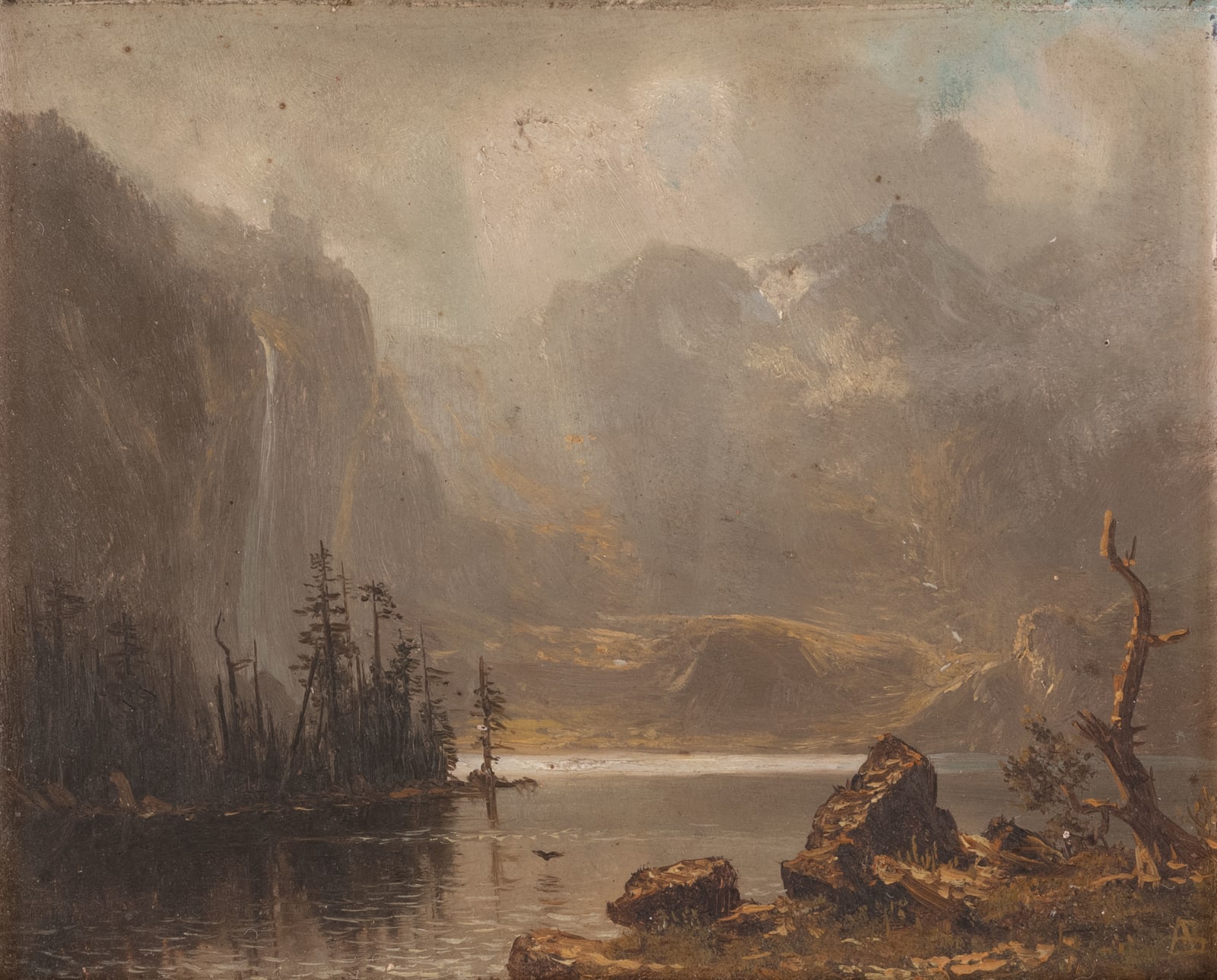-
Artworks
Albert Bierstadt German, American, 1830-1902
Mountain Landscape, undatedOil on paper on board5 x 6 inches
12.7 x 15.2 cmSigned with the artist's monogram at lower right: ABSoldTwo of the most fascinating works in the Osborn collection interpret Albert Bierstadt’s signature western terrains in contrasting modes. While both Mountain Landscape and View in the Sierras defy precise...Two of the most fascinating works in the Osborn collection interpret Albert Bierstadt’s signature western terrains in contrasting modes. While both Mountain Landscape and View in the Sierras defy precise topographical identification, they clearly reference iconic features first encountered by the artist on his 1863 painting expeditions in the Yosemite Valley and the surrounding Sierra Nevada Mountains. These resonant sites would be portrayed with varying degrees of both topographical precision and romantic license for the rest of Bierstadt’s career.
For example, while Bierstadt assigned a regional title to View in the Sierras, another hand later identified the subject as Kings River Canyon. Indeed, a series of similar landscapes with varying titles and on different scales were painted in the later 1860s and 1870s testifying to the satisfaction of this particular landscape configuration. The deep park-like foreground with massive trees and grazing deer contained within a bowl of looming snowy peaks resonated for his audiences as it had for Bierstadt who wrote: “We are now here in the garden of Eden I call it. The most magnificent place I was ever in, and I employ every moment painting from nature.” The broad basin of shining water at the center of each version references the river named for Clarence King, the American geologist noted for his survey of the region. The most dramatic of these variations is Among the Sierra Nevada Mountains, California (1868; Smithsonian American Art Museum, Washington, D.C.), in which Bierstadt effectively swells the scale of our intimate cabinet painting to the size of a Great Picture. While the monumental version was, like many of the artist’s works, both admired and critiqued, nevertheless the painting was famous as an exercise in the venerable aesthetics of what we might call the “Beautiful Sublime.”
In contrast, Mountain Landscape although diminutive in size conveys a powerful vision of the Yosemite Valley-Sierra Nevada conflation of terrain as a gloomy region of forbidding danger invoking the opposing landscape mode of the “Terrible Sublime.” The palette is dark. The weather threatens. A torrent plunges headlong down a Yosemite-like sheer wall of granite on the left roiling the dark waters below. At the right snowmelt rushes from remote glacier fields among the high peaks along the facets of a massive ravine down to the waters below. Foreground boulders offer little support to the gnarled storm blasted tree gesturing in the lower right; a victim of nature’s forces over time and an actor in the terrible sublime right out of the landscapes of Thomas Cole. Bierstadt’s energetic application of paint to this tiny surface also contributes to the outsized impact of this tiny gem. Is this site on the map? Does it really matter?
—Linda S. Ferber, excerpt from "Small but Sublime: Albert Bierstadt Oil Studies and Cabinet Paintings," 2024
Provenance
The artist; to
William Godfrey Mayer and Esther Luceta Osborn (the artist’s wife’s sister), Waterville, New York; to
Dr. Edward Randall and Harriet Ada Pauline Mayer (their daughter), Waterville, New York; to
Orville DeForest Edwards and Joyce Edwards (née Randall, their daughter, d. 2000), Dobbs Ferry, New York, until 2000; to
Mr. Orville DeForest Edwards, Dobbs Ferry, New York, 2000-2015;
By descent to private collection, 2015 until the present
Exhibitions
Schoelkopf Gallery, New York, Small But Sublime: Albert Bierstadt Cabinet Paintings and Oil Studies, January 19–February 23, 20241of 3
Subscribe to our mailing list to receive updates from the gallery
* denotes required fields
We will process the personal data you have supplied in accordance with our privacy policy (available on request). You can unsubscribe or change your preferences at any time by clicking the link in our emails.

